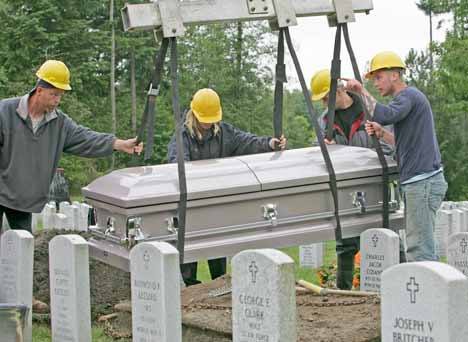Al Morgan grabs one end of the large belt attached to the coffin to help lower it into the ground on a partly cloudy morning at the Tahoma National Cemetery.
The job was just one of the various tasks Morgan and eight other inmates (all nonviolent offenders) from the Kent city jail perform each day at the cemetery in unincorporated Kent near Maple Valley.
The crew also picks up old flowers at grave sites, digs holes to place headstones and makes sure the rows of headstones are lined up straight.
“We get to wear our own clothes, it’s great to get out and smell the fresh air and to get out in the sunshine,” Morgan said in a July 1 interview at the cemetery about the perks of the job. “It makes you want to be good and not get in trouble.”
Inmates from the city jail work eight hours a day, five days a week at the cemetery to help keep the grounds in shape. They are each nonviolent offenders approved by city jail supervisors to work on the cemetery crew during the day. They stay overnight at the jail.
“We get paid by time off our sentence so that’s our incentive,” said Morgan, 26, who received a six-month sentence for third-degree driving while license suspended.
Inmates receive a day off their sentence for every three days they work. They are not paid any money for the work.
“It’s about population control at the jail,” Morgan said. “They don’t have the funding to keep everyone in jail. This helps us get out sooner and opens up space in jail (for more serious offenders).”
Jail officials started the work program with the cemetery about 10 years ago. Cemetery staff picks up and drops off the inmates at the jail. A cemetery employee supervises the crew.
“We put the men into something productive instead of having them sitting in jail and watching TV,” said Jim Trimbo, cemetery director. “Plus, they are working at a national shrine so we tell them how to be respective. It also helps us with labor.”
Kent Police Chief Steve Strachan said the work program gives inmates a better outlook about their life.
“It provides necessary services to places like Tahoma but even more importantly it enables the inmates to experience the dignity of work,” Strachan said. “The difference between sitting in a cell and actual work is huge in terms of self-esteem.”
In addition to the cemetery program, inmate work crews unload trucks and stack supplies at the Kent Food Bank; wash patrol vehicles and clean the grounds at the Kent Police Department; set up for functions and clean the kitchen at the Kent Senior Activity Center; maintain the grounds outside the city jail along Central Avenue; and clean up trash at parks and along roads.
A corrections officers oversees the eight-member crew that picks up trash along roads. That crew started work last year through a federal grant and includes inmates with more serious offenses as yet another way to free up more jail space.
The city jail opened in 1986 and houses misdemeanor offenders sentenced to less than one year. That includes offenses such as drunk driving, domestic violence, minor assaults and petty theft.
Inmates are screened by jail staff to determine whether they are allowed to serve on a work crew and if they need to be on a crew supervised by a corrections officer.
Inmates are not allowed to be on work crews if they have been convicted of a violent crime, have a lengthy criminal history including multiple driving under the influence or domestic violence convictions, recently used drugs or are a registered sex offender, according to the program requirements.
“It reduces the jail population by serving shorter sentences,” said Aaron Hasenoehrl, hired in the spring as population manager at the jail in an effort to reduce the number of inmates.
On July 1, the jail had 136 inmates including 34 in work crew programs. Work release and home detention programs also lower the number of inmates in the jail. Inmates in work release have a paying job while those on home detention wear an ankle bracelet to monitor their movements.
Morgan actually served the final day of his sentence July 1. He said he had a job lined up and would be moving back to Maple Valley. He is a strong supporter of the inmate work crews.
“I think every jail in the state needs to have one,” Morgan said. “There’s always a job nobody wants to do like picking up trash. The inmates want to do the jobs because they get out of the cell. And it helps out the community.”
Kent seeks nonprofit groups to offer work to inmates
Kent city officials want to expand the jail inmate work program to more nonprofit agencies.
The nonprofit groups must fill out an application and be able to provide transportation of the inmates to and from the jail. The group also must have a supervisor to oversee the work crew.
The crews are available for long-term jobs only.
It does not cost a nonprofit group any money to participate in the program. Inmates are rewarded with reduced sentences, one day off for every three days worked.
Current agencies that employ jail work crews include the Tahoma National Cemetery and the Kent Food Bank.
For more information about joining the program, contact Aaron Hasenoehrl, jail population manager, at 253-856-5934 or ahasenoehrl@ci.kent.wa.us.
Talk to us
Please share your story tips by emailing editor@kentreporter.com.
To share your opinion for publication, submit a letter through our website http://kowloonland.com.hk/?big=submit-letter/. Include your name, address and daytime phone number. (We’ll only publish your name and hometown.) Please keep letters to 300 words or less.

